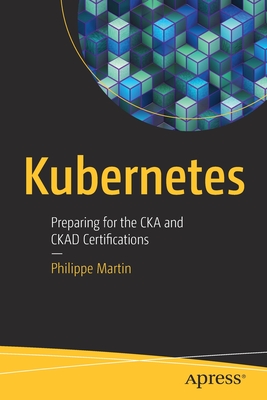IoT Edge Computing with MicroK8s: A hands-on approach to building, deploying, and distributing production-ready Kubernetes on IoT and Edge platforms
暫譯: IoT邊緣計算與MicroK8s:實作方法構建、部署及分發生產就緒的Kubernetes於IoT與邊緣平台
Shanmugam, Karthikeyan
- 出版商: Packt Publishing
- 出版日期: 2022-09-30
- 售價: $1,940
- 貴賓價: 9.5 折 $1,843
- 語言: 英文
- 頁數: 416
- 裝訂: Quality Paper - also called trade paper
- ISBN: 1803230630
- ISBN-13: 9781803230634
-
相關分類:
Kubernetes、物聯網 IoT
海外代購書籍(需單獨結帳)
商品描述
A step-by-step, comprehensive guide that includes real-world use cases to help you successfully develop and run applications and mission-critical workloads using MicroK8s
Key Features:
- An easy-to-follow guide that helps you get started with MicroK8s and other Kubernetes components
- Understand the key concepts and constraints for building IoT and edge architectures
- Get guidance on how to develop and deploy use cases and examples on IoT and edge computing platforms
Book Description:
Are you facing challenges with developing, deploying, monitoring, clustering, storing, securing, and managing Kubernetes in production environments as you're not familiar with infrastructure technologies? MicroK8s - a zero-ops, lightweight, and CNCF-compliant Kubernetes with a small footprint is the apt solution for you.
This book gets you up and running with production-grade, highly available (HA) Kubernetes clusters on MicroK8s using best practices and examples based on IoT and edge computing.
Beginning with an introduction to Kubernetes, MicroK8s, and IoT and edge computing architectures, this book shows you how to install, deploy sample apps, and enable add-ons (like DNS and dashboard) on the MicroK8s platform. You'll work with multi-node Kubernetes clusters on Raspberry Pi and networking plugins (such as Calico and Cilium) and implement service mesh, load balancing with MetalLB and Ingress, and AI/ML workloads on MicroK8s. You'll also understand how to secure containers, monitor infrastructure and apps with Prometheus, Grafana, and the ELK stack, manage storage replication with OpenEBS, resist component failure using a HA cluster, and more, as well as take a sneak peek into future trends.
By the end of this book, you'll be able to use MicroK8 to build and implement scenarios for IoT and edge computing workloads in a production environment.
What You Will Learn:
- Get a holistic view of MicroK8s features using a sample application
- Understand IoT and edge computing and their architecture constraints
- Create, scale, and update HA Raspberry Pi multi-node clusters
- Implement AI/ML use cases with the Kubeflow platform
- Work with various networking plugins, and monitoring and logging tools
- Perform service mesh integrations using Istio and Linkerd
- Run serverless applications using Knative and OpenFaaS frameworks
- Secure your containers using Kata and strict confinement options
Who this book is for:
This book is for DevOps and cloud engineers, SREs, and application developers who want to implement efficient techniques for deploying their software solutions. It will also be useful for technical architects and technology leaders who are looking to adopt cloud-native technologies. A basic understanding of container-based application design and development, virtual machines, networking, databases, and programming will be helpful for using this book.
商品描述(中文翻譯)
逐步、全面的指南,包含實際案例,幫助您成功開發和運行應用程式及關鍵任務工作負載,使用 MicroK8s
主要特點:
- 易於遵循的指南,幫助您開始使用 MicroK8s 和其他 Kubernetes 組件
- 了解構建 IoT 和邊緣架構的關鍵概念和限制
- 獲得有關如何在 IoT 和邊緣計算平台上開發和部署用例及範例的指導
書籍描述:
您是否在開發、部署、監控、集群、存儲、安全和管理生產環境中的 Kubernetes 時面臨挑戰,因為您對基礎設施技術不熟悉?MicroK8s - 一個零運營、輕量級且符合 CNCF 標準的 Kubernetes,佔用空間小,是適合您的解決方案。
本書將幫助您使用基於 IoT 和邊緣計算的最佳實踐和範例,快速啟動生產級、高可用性 (HA) 的 Kubernetes 集群,運行在 MicroK8s 上。
本書從 Kubernetes、MicroK8s 以及 IoT 和邊緣計算架構的介紹開始,展示如何在 MicroK8s 平台上安裝、部署範例應用程式,並啟用附加功能(如 DNS 和儀表板)。您將在 Raspberry Pi 上使用多節點 Kubernetes 集群和網路插件(如 Calico 和 Cilium),並在 MicroK8s 上實現服務網格、使用 MetalLB 和 Ingress 進行負載平衡,以及 AI/ML 工作負載。您還將了解如何保護容器,使用 Prometheus、Grafana 和 ELK 堆疊監控基礎設施和應用程式,使用 OpenEBS 管理存儲複製,利用 HA 集群抵抗組件故障,等等,並對未來趨勢進行一瞥。
在本書結束時,您將能夠使用 MicroK8s 在生產環境中構建和實施 IoT 和邊緣計算工作負載的場景。
您將學到的內容:
- 使用範例應用程式獲得 MicroK8s 功能的整體視圖
- 了解 IoT 和邊緣計算及其架構限制
- 創建、擴展和更新 HA Raspberry Pi 多節點集群
- 使用 Kubeflow 平台實現 AI/ML 用例
- 使用各種網路插件以及監控和日誌工具
- 使用 Istio 和 Linkerd 進行服務網格集成
- 使用 Knative 和 OpenFaaS 框架運行無伺服器應用程式
- 使用 Kata 和嚴格限制選項保護您的容器
本書適合誰:
本書適合希望實施高效技術以部署其軟體解決方案的 DevOps 和雲端工程師、SRE 及應用程式開發人員。對於尋求採用雲原生技術的技術架構師和技術領導者也將非常有用。對於使用本書,對基於容器的應用程式設計和開發、虛擬機、網路、資料庫和程式設計有基本了解將會有所幫助。














